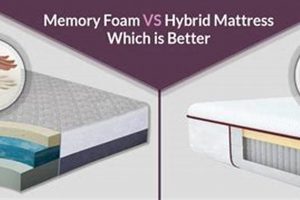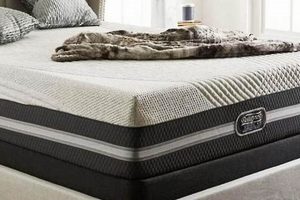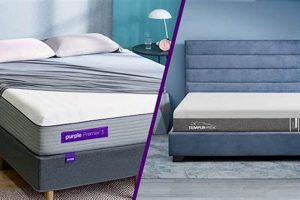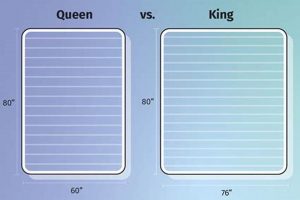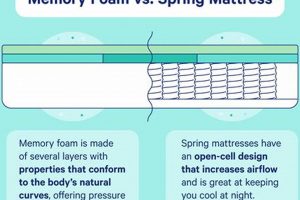The differentiation between innerspring and viscoelastic polyurethane foam sleeping surfaces is a fundamental consideration for consumers seeking optimal sleep support. These two dominant types offer distinct construction, feel, and performance characteristics. Innerspring models rely on a network of coils to provide support, while viscoelastic polyurethane foam conforms to the sleeper’s body shape.
Selecting an appropriate sleeping surface is crucial for promoting restorative sleep and mitigating pressure points. The choice can significantly impact spinal alignment and overall comfort levels. Historically, innerspring models were the standard, but the development of viscoelastic polyurethane foam introduced a new paradigm, offering potential benefits for pressure relief and motion isolation.
A comprehensive examination of the properties of each type is essential for informed decision-making. The following sections will explore factors such as support, pressure relief, temperature regulation, durability, and cost to provide a comparative analysis of innerspring and viscoelastic polyurethane foam options.
Selection Guidance
The decision to acquire a spring or viscoelastic polyurethane foam sleeping surface should be guided by individual needs and preferences. Considering specific requirements ensures optimal satisfaction and long-term suitability.
Tip 1: Assess Support Needs: Individuals requiring robust support, particularly those with higher body weight, may find innerspring models more suitable. The coil system provides a firmer and more resilient feel.
Tip 2: Evaluate Pressure Relief: Viscoelastic polyurethane foam excels at conforming to the body’s contours, distributing weight evenly and alleviating pressure points. This can be beneficial for individuals experiencing joint pain or discomfort.
Tip 3: Consider Temperature Regulation: Traditional viscoelastic polyurethane foam can retain heat. Look for models incorporating cooling technologies, such as gel infusions or open-cell structures, to mitigate this effect. Innerspring models generally offer better breathability due to airflow within the coil system.
Tip 4: Factor in Motion Isolation: Viscoelastic polyurethane foam effectively absorbs motion, minimizing disturbances from a partner’s movements. Innerspring models, particularly those with interconnected coils, tend to transfer motion more readily.
Tip 5: Determine Budget: The cost can vary significantly depending on materials, construction, and brand. Establish a budget range and compare options within that range to identify the best value proposition.
Tip 6: Investigate Durability: The lifespan of a sleeping surface depends on the quality of materials and construction. Research the manufacturer’s reputation and warranty terms to gauge expected longevity.
Tip 7: Test Before Purchase: Whenever possible, physically test different models in a retail setting. Lie on the sleeping surface in various sleeping positions to assess comfort and support.
Careful consideration of these factors will facilitate a more informed decision, increasing the likelihood of selecting a sleeping surface that meets individual needs and promotes restful sleep.
The following section will summarize the key distinctions between these types to help readers make a final choice.
1. Support and firmness
Support and firmness are fundamental attributes that significantly influence the suitability of sleeping surfaces. The interaction between these properties and the construction of innerspring or viscoelastic polyurethane foam options determines spinal alignment and overall comfort.
- Coil Gauge and Density (Innerspring)
In innerspring models, coil gauge, measured in millimeters, and coil density, reflecting the number of coils, dictate the level of support. Lower gauge numbers indicate thicker coils, resulting in a firmer surface. Higher coil densities typically enhance contouring and weight distribution. For example, an innerspring surface with a low coil gauge is preferable for individuals requiring enhanced lumbar support. These specifications directly influence the compression rate of the spring and the overall feel.
- Foam Density and Indentation Load Deflection (ILD) (Memory Foam)
Viscoelastic polyurethane foam mattresses rely on foam density, measured in pounds per cubic foot, and Indentation Load Deflection (ILD), a measure of firmness. Higher density foams tend to be more durable and supportive. ILD values indicate the force required to compress the foam by a specific percentage, providing an objective measure of firmness. A high ILD number suggests a firmer feel. A higher-density viscoelastic polyurethane foam mattress with a moderate ILD is suitable for individuals seeking a balance of support and pressure relief.
- Zoning and Targeted Support
Both innerspring and viscoelastic polyurethane foam surfaces may incorporate zoning to provide targeted support to different areas of the body. For innerspring options, this can involve varying coil gauges or densities in different zones. In viscoelastic polyurethane foam models, zoning can be achieved through variations in foam density or the inclusion of support cores. Mattresses with enhanced lumbar support zones are designed to maintain spinal alignment and reduce back pain. This design element tailors the surface to accommodate the bodys natural curves.
- Hybrid Constructions
The strengths of both innerspring and viscoelastic polyurethane foam can be combined in hybrid designs. These surfaces typically feature an innerspring core for support with a viscoelastic polyurethane foam comfort layer for pressure relief. The thickness and density of the viscoelastic polyurethane foam layer significantly impact the overall firmness and feel. A hybrid mattress with a thick, high-density viscoelastic polyurethane foam comfort layer is suitable for individuals who want the support of coils with the contouring benefits of viscoelastic polyurethane foam.
The interplay of these characteristics defines the supportive properties of a mattress. The assessment of innerspring and viscoelastic polyurethane foam surfaces requires careful attention to construction details to determine their suitability for individual needs. Choosing between these construction types requires an informed awareness of individual preference.
2. Pressure point relief
Pressure point relief is a critical determinant in the selection of sleeping surfaces, significantly influencing sleep quality and overall comfort. The distribution of body weight across the sleeping surface directly impacts the formation of pressure points, which can impede circulation and trigger discomfort, leading to restlessness and fragmented sleep. In the context of innerspring versus viscoelastic polyurethane foam mattresses, the ability to mitigate these pressure points varies considerably due to the distinct material properties and construction methods employed. Viscoelastic polyurethane foam, by its nature, conforms to the sleeper’s body contours, effectively distributing weight across a larger surface area and minimizing localized pressure. Conversely, innerspring models, with their coil-based support systems, tend to provide more localized support, which can exacerbate pressure points, particularly at areas like the hips, shoulders, and knees. An example of the practical significance lies in the experiences of individuals with arthritis or fibromyalgia, who often report greater relief from viscoelastic polyurethane foam surfaces due to their pressure-relieving properties.
However, the effectiveness of pressure point relief in any sleeping surface is not solely determined by material type. Factors such as foam density, coil configuration, and the presence of comfort layers play crucial roles. Innerspring models incorporating individually wrapped coils or those with substantial comfort layers made of materials like latex or viscoelastic polyurethane foam can offer improved pressure relief compared to traditional interconnected coil systems. Similarly, viscoelastic polyurethane foam surfaces with excessively high densities or those lacking adequate ventilation can create their own pressure-related issues due to increased heat retention and reduced conformity. The practical application of this understanding lies in the need for consumers to consider not only the broad category of sleeping surface but also the specific features and specifications of individual models. For example, hybrid mattresses that combine the support of innerspring coils with the pressure-relieving properties of viscoelastic polyurethane foam are designed to provide a balanced approach, addressing both support and comfort needs.
In summary, while viscoelastic polyurethane foam is generally recognized for its superior pressure point relief capabilities, the choice between innerspring and viscoelastic polyurethane foam sleeping surfaces necessitates a nuanced evaluation of individual preferences, physical conditions, and specific product features. The goal is to identify a surface that effectively minimizes pressure points, promotes healthy circulation, and ultimately contributes to restful, restorative sleep. The primary challenge involves balancing the need for adequate support with the desire for optimal pressure relief. Informed decision-making, guided by an understanding of material properties and individual needs, is paramount.
3. Temperature regulation
Temperature regulation represents a significant consideration when evaluating sleeping surfaces. The capacity of a mattress to dissipate heat and maintain a comfortable sleeping temperature directly influences sleep quality. Disparities in material composition between innerspring and viscoelastic polyurethane foam models give rise to differing thermal properties.
- Airflow and Breathability in Innerspring Models
Innerspring models inherently promote greater airflow due to the open structure of the coil system. The spaces between the coils facilitate the circulation of air, allowing for the dissipation of heat away from the sleeper’s body. This increased breathability can be advantageous for individuals prone to overheating during sleep. For example, individuals residing in warmer climates often find innerspring mattresses more comfortable due to their ability to maintain a cooler surface temperature. The direct implication is enhanced thermal regulation and a reduction in the likelihood of sleep disruption due to overheating.
- Heat Retention in Viscoelastic Polyurethane Foam Mattresses
Viscoelastic polyurethane foam, characterized by its dense structure, exhibits a tendency to retain heat. The reduced airflow within the foam matrix impedes the dissipation of body heat, potentially leading to a build-up of warmth and discomfort. This characteristic presents a challenge for individuals sensitive to temperature fluctuations during sleep. However, manufacturers have introduced various technologies to mitigate heat retention, such as incorporating gel infusions or open-cell structures within the foam. These modifications aim to improve breathability and enhance thermal regulation. For instance, a viscoelastic polyurethane foam mattress infused with gel particles may provide a cooler sleeping experience compared to a traditional viscoelastic polyurethane foam model.
- Material Composition and Thermal Conductivity
The specific materials used in the construction of sleeping surfaces significantly impact thermal conductivity. Natural materials like cotton and wool tend to exhibit better breathability and moisture-wicking properties compared to synthetic materials. The use of natural fibers in the cover of a mattress can contribute to enhanced temperature regulation. Conversely, synthetic materials may restrict airflow and contribute to heat retention. For example, a mattress cover made of bamboo fabric can promote a cooler sleeping surface due to its breathability and moisture-wicking capabilities. The implication is that the choice of cover material plays a crucial role in managing temperature and comfort.
- Design Innovations for Temperature Regulation
Manufacturers continuously innovate to address the issue of heat retention in sleeping surfaces. Design modifications such as ventilated foam layers, phase-change materials, and specialized fabrics are implemented to enhance airflow and improve temperature regulation. Ventilated foam layers incorporate channels or perforations to promote air circulation within the mattress. Phase-change materials absorb and release heat to maintain a consistent temperature. Specialized fabrics wick away moisture to keep the sleeper cool and dry. For example, a mattress incorporating a phase-change material may adapt to the sleeper’s body temperature, providing a more comfortable sleeping environment. The implication is that technological advancements offer potential solutions to the challenges of temperature regulation in sleeping surfaces.
The interplay between these facets underscores the importance of considering temperature regulation when selecting a sleeping surface. The choice between innerspring and viscoelastic polyurethane foam models, as well as the specific features incorporated into each type, directly impacts thermal comfort and sleep quality. Understanding these nuances allows for informed decision-making, tailored to individual preferences and environmental conditions.
4. Motion transfer impact
Motion transfer refers to the degree to which movement on one area of a sleeping surface is felt on other areas. This characteristic is particularly pertinent for individuals sharing a bed, as excessive motion transfer can disrupt sleep cycles. The core construction of innerspring and viscoelastic polyurethane foam surfaces dictates their respective motion isolation capabilities. Innerspring models, characterized by interconnected coil systems, tend to transmit motion readily across the sleeping surface. The movement in one area causes a ripple effect, which can be felt by a partner. Viscoelastic polyurethane foam, in contrast, excels at absorbing and isolating motion. The dense, conforming nature of the foam dampens movement, minimizing disturbance to other areas. For example, a person tossing and turning on one side of a viscoelastic polyurethane foam sleeping surface is less likely to be felt by their partner compared to an innerspring model.
The practical significance of this distinction is evident in scenarios involving individuals with varying sleep schedules or those prone to restlessness. Couples with different bedtimes or those experiencing conditions like restless legs syndrome may benefit substantially from the motion isolation properties of viscoelastic polyurethane foam. The reduction in sleep disturbances contributes to improved sleep quality and overall well-being. Furthermore, the type of coil system within an innerspring model can influence motion transfer. Individually wrapped coils, also known as pocketed coils, reduce motion transfer compared to interconnected coil systems. However, even with pocketed coils, viscoelastic polyurethane foam generally provides superior motion isolation. The composition and density of the foam layers above the coils also play a role. Thicker, higher-density foam layers enhance motion absorption. Hybrid mattresses, combining innerspring coils with viscoelastic polyurethane foam comfort layers, represent a compromise, offering some degree of motion isolation while retaining the support characteristics of innerspring models.
In summary, motion transfer is a critical factor in selecting a sleeping surface, especially for couples. Viscoelastic polyurethane foam mattresses generally outperform innerspring models in minimizing motion transfer due to their inherent material properties. However, design variations within both innerspring and viscoelastic polyurethane foam categories can influence motion isolation capabilities. The ultimate choice hinges on individual needs and preferences, with careful consideration given to the potential impact of motion transfer on sleep quality. Addressing motion transfer concerns is vital for ensuring uninterrupted and restful sleep for all occupants of the bed.
5. Long-term durability
Long-term durability is a primary consideration when selecting a sleeping surface. The ability of a mattress to maintain its support, comfort, and structural integrity over an extended period directly impacts its value proposition. The inherent material properties and construction techniques employed in innerspring and viscoelastic polyurethane foam models influence their respective lifespans.
- Coil Fatigue and Support Degradation (Innerspring)
In innerspring models, coil fatigue represents a significant factor affecting long-term durability. Repeated compression and decompression cycles can lead to a gradual loss of coil springiness, resulting in sagging and diminished support. The gauge and quality of the steel used in the coils, as well as the overall construction of the innerspring unit, influence the rate of coil fatigue. For example, innerspring mattresses with lower-gauge coils or those lacking reinforced edge support may exhibit signs of sagging within a few years. The result is reduced support and compromised sleep quality.
- Foam Density and Compression Set (Memory Foam)
Viscoelastic polyurethane foam mattresses are susceptible to compression set, which refers to the permanent deformation of the foam material under sustained pressure. Lower-density foams are more prone to compression set, resulting in a loss of support and contouring ability over time. Higher-density foams exhibit greater resistance to compression set, extending the lifespan of the mattress. For example, a viscoelastic polyurethane foam mattress with a density of 5 pounds per cubic foot is likely to maintain its shape and support for a longer period compared to a model with a density of 3 pounds per cubic foot. The consequence is greater long-term value and sustained comfort.
- Material Degradation and Environmental Factors
Exposure to environmental factors such as humidity, temperature fluctuations, and direct sunlight can accelerate the degradation of mattress materials, regardless of type. Humidity can promote the growth of mold and mildew, while temperature fluctuations can cause expansion and contraction, leading to structural damage. Direct sunlight can degrade foam materials, reducing their elasticity and support. The use of protective mattress covers and proper ventilation can mitigate the impact of these environmental factors. For instance, a waterproof mattress protector can prevent moisture penetration and extend the lifespan of both innerspring and viscoelastic polyurethane foam models.
- Construction Quality and Manufacturing Standards
The quality of construction and adherence to manufacturing standards significantly influence the long-term durability of sleeping surfaces. Mattresses constructed with reinforced seams, high-quality adhesives, and durable cover materials are more likely to withstand the rigors of daily use. Reputable manufacturers typically employ stringent quality control measures to ensure consistent performance and longevity. Investing in a mattress from a well-established brand with a strong reputation for quality can provide greater assurance of long-term durability. The underlying principle is that superior craftsmanship translates to a more resilient and enduring product.
In conclusion, long-term durability is a multifaceted consideration when comparing innerspring and viscoelastic polyurethane foam mattresses. Factors such as coil fatigue, foam density, material degradation, and construction quality all contribute to the overall lifespan of a sleeping surface. Understanding these nuances enables consumers to make informed decisions, selecting a mattress that provides sustained support, comfort, and value over the long term. The careful assessment of these factors is crucial for maximizing the return on investment in a sleeping surface.
Frequently Asked Questions
This section addresses common inquiries regarding the selection and performance characteristics of innerspring and viscoelastic polyurethane foam mattresses. The information provided aims to clarify key differences and assist consumers in making informed decisions.
Question 1: What distinguishes the support system in innerspring from that of viscoelastic polyurethane foam models?
Innerspring mattresses employ a network of coils to provide support, while viscoelastic polyurethane foam relies on its density and conforming properties to distribute weight and alleviate pressure points. The coil system offers a more resilient feel, whereas viscoelastic polyurethane foam provides a contouring effect.
Question 2: How does temperature regulation differ between the two mattress types?
Innerspring models generally exhibit better airflow due to the open structure of the coil system, facilitating heat dissipation. Viscoelastic polyurethane foam tends to retain heat, although design innovations like gel infusions and open-cell structures aim to improve breathability.
Question 3: Which mattress type is more effective at minimizing motion transfer?
Viscoelastic polyurethane foam excels at absorbing and isolating motion, reducing disturbances from a partner’s movements. Innerspring models, particularly those with interconnected coils, tend to transmit motion more readily.
Question 4: What factors influence the long-term durability of each mattress type?
In innerspring models, coil fatigue is a primary concern, leading to sagging and diminished support over time. Viscoelastic polyurethane foam mattresses are susceptible to compression set, which can result in a loss of support and contouring ability. Material quality and construction techniques play a significant role in both cases.
Question 5: How does the cost compare between innerspring and viscoelastic polyurethane foam mattresses?
The cost can vary significantly depending on factors such as materials, construction, and brand. Generally, basic innerspring models may be more affordable, while high-density viscoelastic polyurethane foam or hybrid models can command a higher price.
Question 6: Are there specific sleeping positions that are better suited for one mattress type over the other?
Side sleepers may benefit from the pressure-relieving properties of viscoelastic polyurethane foam, while back and stomach sleepers may prefer the firmer support of innerspring models. However, individual preferences and body weight should also be considered.
The selection of an appropriate sleeping surface requires a careful evaluation of individual needs, preferences, and budgetary constraints. A thorough understanding of the distinct characteristics of innerspring and viscoelastic polyurethane foam mattresses facilitates informed decision-making.
The following section will provide a comparative summary of the advantages and disadvantages of each mattress type, consolidating the key points discussed throughout this article.
Conclusion
The preceding analysis has delineated the critical distinctions between “spring vs memory foam mattress” options. Innerspring surfaces provide resilient support and enhanced airflow, while viscoelastic polyurethane foam surfaces offer superior pressure relief and motion isolation. Durability is influenced by coil fatigue in innerspring and compression set in viscoelastic polyurethane foam models. Ultimately, the selection hinges on individual needs, sleeping preferences, and budgetary considerations.
A judicious assessment of personal requirements is paramount for optimizing sleep quality. The information presented serves to empower consumers in navigating the complexities of the mattress market, facilitating a well-informed decision aligned with long-term comfort and well-being. Continued advancements in materials science and design promise further enhancements to both innerspring and viscoelastic polyurethane foam technologies, potentially blurring the lines between these established categories.


